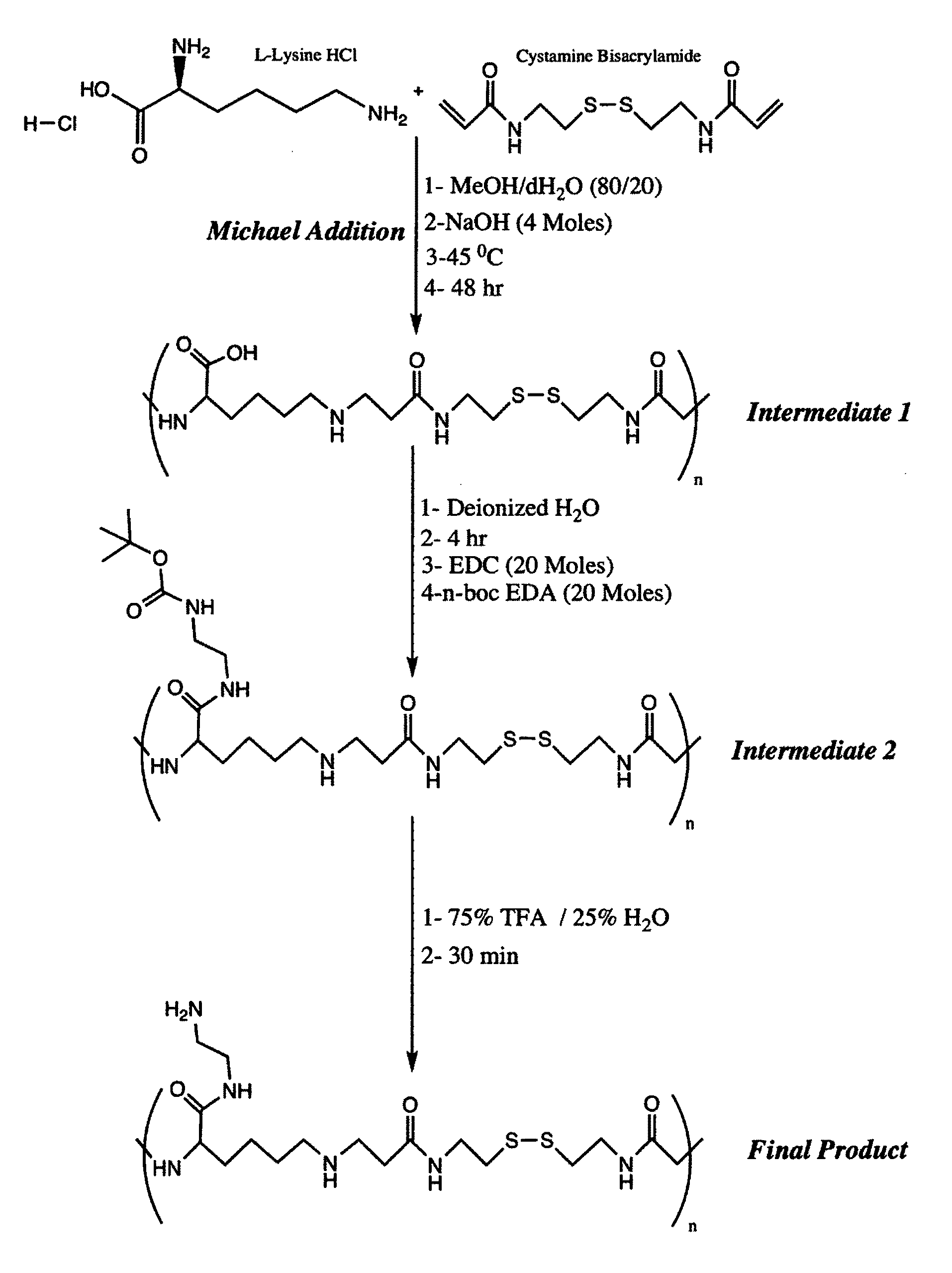Reducible polymers for nonviral gene delivery
a nonviral, copolymer technology, applied in the direction of peptides/protein ingredients, immunoglobulins, peptides/protein ingredients, etc., can solve the problems of prolonged cytotoxicity, significant problem of carrier translation, and prior art deficient in disulfide-reducible linear l-lysine-modified copolymers
- Summary
- Abstract
- Description
- Claims
- Application Information
AI Technical Summary
Benefits of technology
Problems solved by technology
Method used
Image
Examples
example 1
Materials and Methods
Chemicals and Equipment
[0054]N-butyloxycarbonyl ethylenediamine, L-lysine HCl, hyperbranched polyethylenimine (bPEI, Mw 25 kDa), trifluoroacetic acid (TFA), poly L-Lysine (PLL; MW 20.9 kDa), dithiothreitol (DTT), ethidium bromide (EtBr), cesium chloride (CsCl), ninhydrin reagent, and 3-(4,5-dimethyl-2-thiazolyl)-2,5-diphenyl-2H-tetrazolium bromide (MTT) are purchased from Sigma-Aldrich (St. Louis, Mo.). N,N_-cystaminebisacrylamide (CBA) is purchased from PolySciences, Inc. (Warrington, Pa.). Dulbecco's Modified Eagle's Medium (DMEM), penicillin-streptomycin, fetal bovine serum (FBS), trypsin-like enzyme (TrypLE Express), Maxiprep kit, and Dulbecco's phosphate buffered saline (PBS) are purchased from Invitrogen-Gibco (Carlsbad, Calif.). Luciferase assay system with reporter lysis buffer and RQ1 RNase-free DNase I enzymes are purchased from Promega (Madison, Wis.). SlowFade® Gold antifade reagent, ethidium monoazide and DAPI are purchased from Invitrogen (Carlsbad...
example 2
Polymer Synthesis
Synthesis of Reducible Linear L-Lysine-Modified Copolymers (LLC) Without Ethylenediamine
[0076]
[0077]The lysine monomers are activated by neutralization of the acid form of the amino acid with sodium hydroxide (NaOH). The activated lysine is then reacted with CBA in a Michael addition reaction. Briefly, 730.6 mg (4 moles) L-lysine HCl and 1060 mg (4 moles) CBA are weighed and transferred to a 50 mL round bottom flask. Afterwards, 160 mg (4 moles) of NaOH is used to neutralize the HCl present in the L-lysine starting material. Then, 10 mL of methanol / water (MeOH / H2O) mixture of 80 / 20 volume ratio are added to the flask, which is then stirred in an oil bath at 45° C. to dissolve the reagents. The reaction is then stirred in the dark under a nitrogen atmosphere for 2 days (FIG. 1, Intermediate 1). The resulting solution is then dissolved in ultrapure water and the reaction solution is purified via dialysis (MWCO 2000) against water for 2 days to remove low molecular wei...
example 3
Transfection and Cytotoxicity of Polyplexes
In Vitro Transfection Efficiency
[0090]The luciferase assay showed that LLC / pDNA polyplexes of N / P ratio 40 / 1 resulted in a 5.5-fold higher transfection efficiency in comparison to the optimal PLL control at an N / P ratio of 50 / 1 in HDF cells (p<0.05) (FIG. 6A). The LLC / pDNA polyplexes of N / P ratio 20 / 1 showed a 3-fold higher gene transfection efficiency than the optimal PLL control at an N / P ratio of 20 / 1 in MCF-7 cells (p<0.05) (FIG. 6B). In MA cells, the LLC / pDNA polyplexes at an N / P ratio of 50 / 1 resulted in a 4.4-fold higher gene transfection efficiency than the optimal PLL control at an N / P ratio of 50 / 1 (p<0.05) (FIG. 6C). These higher transfection efficiencies of the LLCs as compared to the PLL control could be attributed to the more efficient release of the pDNA from the LLC polyplexes into the cytosol of the cells as a result of reduction of the disulfide bonds along the polymer backbone. In addition, the higher transfection efficie...
PUM
| Property | Measurement | Unit |
|---|---|---|
| Fraction | aaaaa | aaaaa |
| Fraction | aaaaa | aaaaa |
| Fraction | aaaaa | aaaaa |
Abstract
Description
Claims
Application Information
 Login to View More
Login to View More - R&D
- Intellectual Property
- Life Sciences
- Materials
- Tech Scout
- Unparalleled Data Quality
- Higher Quality Content
- 60% Fewer Hallucinations
Browse by: Latest US Patents, China's latest patents, Technical Efficacy Thesaurus, Application Domain, Technology Topic, Popular Technical Reports.
© 2025 PatSnap. All rights reserved.Legal|Privacy policy|Modern Slavery Act Transparency Statement|Sitemap|About US| Contact US: help@patsnap.com



